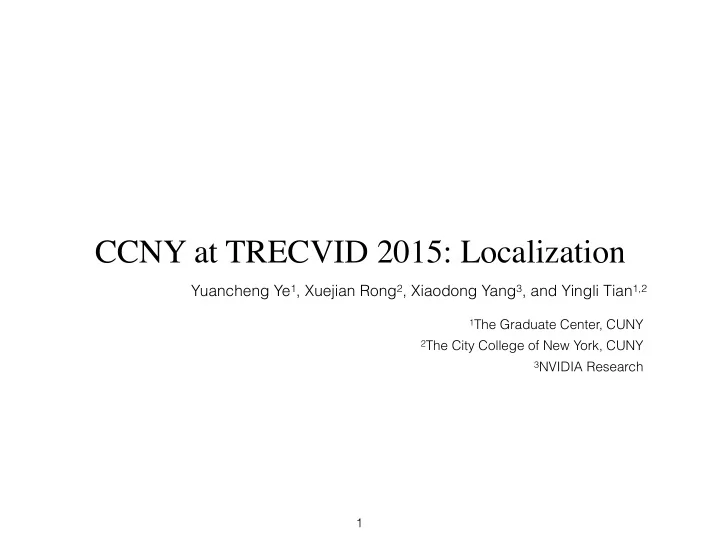

CCNY at TRECVID 2015: Localization Yuancheng Ye 1 , Xuejian Rong 2 , Xiaodong Yang 3 , and Yingli Tian 1,2 1 The Graduate Center, CUNY 2 The City College of New York, CUNY 3 NVIDIA Research 1
Task Description • Concepts Airplane Anchorperson Boat_ship Bridge Bus Computer Motorcycle Telephone Flags Quadruped 2
Determine the presence of the concept temporally within the shot • For each frame that contains the concept, locate a bounding • rectangle spatially Only one which is the most prominent among all submitted • bounding boxes will be used in the judging. 3
Challenges • How to locate object bounding box on each frame accurately? • How to extend the image-based object detection algorithms into the temporal domain? Our solution: Regions with Convolutional Neural Network Features(R-CNN) Region Trajectory Algorithm 4
System Overview • Apply improved image-based R-CNN algorithm on each frame independently. • Propose a novel region trajectory algorithm to extend to temporal dimension. 5
Improved R-CNN Raw input Image Region Proposals CNN Features Classification 6
• Insufficient for object localization in videos Input: Output: How to incorporate temporal info? 7
Region Trajectories Set of detected Set of aligned regions trajectories 8
However…… Input: Output: So many plausible trajectories are introduced! 9
Prune trajectories • Threshold number of regions detected by R − CNN ratio = total number of regions in the trajectory Output after pruning: 10
Data • Training data: - Internet Archive videos with Creative Commons licenses (IACC). - IACC.2.A, IACC.2.B • Totally 100 GB, 400h. • Size mostly 320 x 240. • Ranging from 10s to 6.4m. • Manual (temporal and spatial) annotations provided (.xml format). 11
• Auxiliary Data • AlexNet model is pre-trained on the PASCAL VOC 2007 dataset. • GoogLeNet model is pre-trained on the ILSVRC12 dataset. • Testing data: - IACC.2.C: • A collection of 200h drawn randomly from the IACC.2 collection. • Size mostly 320 x 240. • 18 GB of Master I-Frames will be extracted for evaluation. 12
• Data Format: • I-frames: a sequence of key frames defines which movement the viewer will see, whereas the position of the key frames on the film, video, or animation defines the timing of the movement. • Data Statistics airplane anchor boat_ship bridges bus computers motorcycle telephones flags quadruped person Positive 710 3482 7055 1380 860 4111 1835 3272 8429 6315 I-frames Negative 548 0 4156 1537 2288 0 2036 2064 3156 8595 I-frames Test 7047 14119 5874 6054 4774 15814 4165 5851 19092 13949 I-frames 13
Evaluation Metrics • Precision, Recall and F-Score are calculated based on temporal and spatial results respectively. • Averages are computed for values of each concept. • The computing units are frames (temporally) and pixels (spatially). F - Score = 2 × Precision × Recall Precision + Recall (from Wikipedia) 14
Results • Mean_Per_Run 15
• iframe_fscore per concept • mean_pixel_fscore per concept 16
Results Visualization • Success Examples Airplane Anchorperson Boat_ship Bridge Bus Computer Motorcycle Telephone Flags Quadruped • Failure Examples Airplane Anchorperson Boat_ship Bridge Bus Computer Motorcycle Telephone Flags Quadruped 17
Conclusion • By combining R-CNN and region trajectory algorithm, we propose a robust and effective system for video-based object detection task. • Temporal information can make a contribution to the object detection task in videos. • Among all participant teams, we rank 1st for the measurement of iframe_fscore, and 3rd for the measurement of mean_pixel_fscore. 18
Future Work • Incorporate more accurate image-based object detection algorithms, e.g. , Fast-RCNN. • Improve the region trajectory algorithm for higher spatial accuracy. • Adopt model ensembles to extract more discriminative features from region proposals. 19
Ti ank y ov 20
Recommend
More recommend